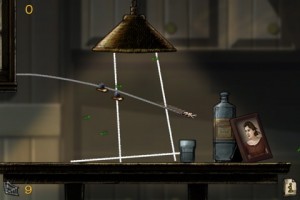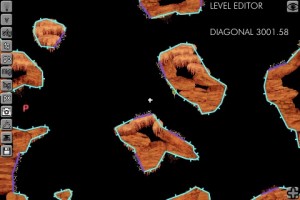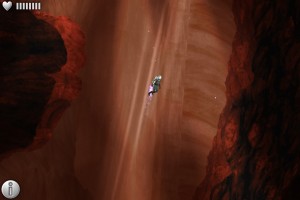 How did your experience with Spider inform the design of Waking Mars? I.e., what aspects of Spider’s gameplay did you want to carry over into your second project, and was there anything you had yet to master in Spider that you’ve been able to improve on in Waking Mars?
How did your experience with Spider inform the design of Waking Mars? I.e., what aspects of Spider’s gameplay did you want to carry over into your second project, and was there anything you had yet to master in Spider that you’ve been able to improve on in Waking Mars?
David: With Spider, we believe that we succeeded in making a game that was built around a very simple mechanic, but also offered depth for highly engaged players to explore in the form of fiction, mastery, alternate game modes, leaderboards, achievements, and so on. One of the keys to success in the volume market of the App Store is in making accessible software. Something that can be understood and engage the player while waiting for the bus.
I feel pretty confident that Waking Mars is a game that can be understood and appreciated by a wide audience – making friendly, approachable games is always going to be a goal of ours – but it’s a bit less immediate than Spider. On the flip side, one of the most common criticisms of Spider was that it was repetitive and not particularly challenging. Waking Mars is a more diverse experience, and it also asks a bit more of its players. The challenge in the game comes less from the hazards of the game world and more from asking the player to understand a rich and varied ecosystem of unfamiliar life forms, and to learn to manipulate the ecosystem through play.
 Is the level editor you’re using to build Waking Mars an evolution on any tools used for Spider, or did the team pretty much start over from scratch in that regard? The Tiger Style dev blog has an excellent piece on parallax scrolling used to create the 3D feel in Waking Mars – are there any other tricks the game engine or editing suite can pull off that have been particularly helpful to the design process?
Is the level editor you’re using to build Waking Mars an evolution on any tools used for Spider, or did the team pretty much start over from scratch in that regard? The Tiger Style dev blog has an excellent piece on parallax scrolling used to create the 3D feel in Waking Mars – are there any other tricks the game engine or editing suite can pull off that have been particularly helpful to the design process?
David: For Spider, our level editor was Photoshop and C++! So the fact that we even have tools now is a big change from Spider, and was one reason why this game took a lot longer to finish. We could not have built this game without the custom tools, but it also took a lot of investment during development to build them.
The engine has undergone a lot of evolution. We started with the Spider codebase but there is very little of it left. Spider levels were multiple large, overlapping images and a collision map. Waking Mars levels are built from hundreds (sometimes thousands) of sprites and the collision is created in an editing tool where the designer draws the physical dimensions of a level. Our tools allow the designers to place animated sprites into the world, arbitrarily place and design particle effects, script behavior using triggers and volumes, and so on.
Also, the editor is built into the simulator, so designers can edit a level and then immediately start playing it. Ultimately, the designers now have a lot more control over everything that goes into a level, and a lot more flexibility to iterate, and those are the really important things that we got by building a suite of editing tools.
 What does one have to do to acquire the kinds of noises that gooey Martian flora and fauna would make? And on the music side of things, is the team going for a really ambitious soundtrack with tons of music, or are you taking a more minimalist approach?
What does one have to do to acquire the kinds of noises that gooey Martian flora and fauna would make? And on the music side of things, is the team going for a really ambitious soundtrack with tons of music, or are you taking a more minimalist approach?
David: We have almost two hours of original score in the game, from some tremendously talented musician friends of ours, and we’re super happy with the way it came out. We intend to sell it on Bandcamp when the game goes live.
Bobby Arlauskas: We decided early on that one thing the sound design needed to do was differentiate things that are familiar, human, and Earthly from the things that are foreign, alien, and Martian. In general, that meant using field recording and Foley sounds for anything related to the human characters, and synthesis for the alien flora and fauna.
The core elements of plants growing and moving were born of late night synthesis exploration sessions. I would hit record and just twist and contort the synth patches for hours. Each plant sound was then born of intense editing of these sources: cutting up that squelchy part and blending it with this oozing part, adding in rings and bells that might be hard to explain fictionally yet sound alien. Granular synthesis was used to layer specific elements into plants, like one plant that can attack with a dangerous bite that has elements of sharp knives mixed into its sounds.
It was important to me that the plant sounds were alien, yet didn’t evoke any obvious synthesizer vibe, while also providing solid player feedback about what the plant is actually doing.


